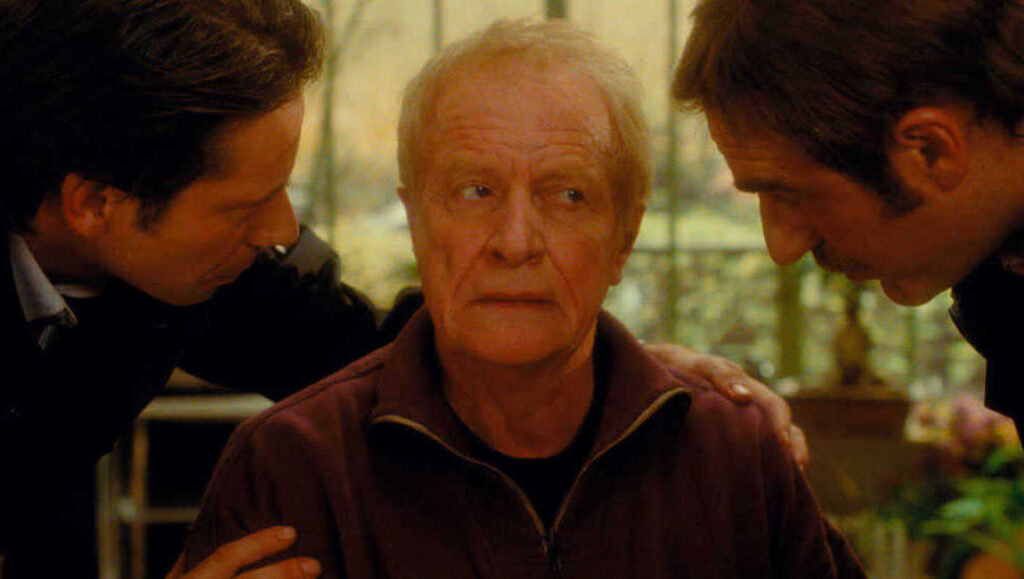Even at the ripe old age of 88, Alain Resnais’s filmmaking engine seems to have an endless supply of creative fuel left. Like clockwork, Resnais churns out a film every four years or so and if his latest offering is any indication, the auteur hasn’t lost the diabolical desire to fragment his cinema. Wild Grass, a mash-up of disjointed mystery and romance tropes, is an odd duck hiding in the tall reeds of the French master’s filmography. It turns a seemingly simple everyday occurrence into a hypnotic psychological dance between two people oddly connected by their overlapping existences. Theirs is a dance of patterns and repetition, fantasy and reality, doubt and redemption, and attempting to make narrative logic of this strange mosaic is a mostly futile exercise. No, one must feel their way through Wild Grass and submit to the overarching themes at work.
Resnais goes big right out the gate, opening with an ominous camera pan of a sunny field and quickly moving toward the dark open doorway of a stone structure. It’s a tracking shot directly aligned with the universe of David Lynch, and it quickly introduces a deviant sense of spatial relationships that will expand over the course of the film. Wild Grass then cross-cuts from shots of tall grass swaying in the wind to a crowded sidewalk, symbolically merging them in one haunting mash cut. This transition introduces the aforementioned story involving Marguerite (Sabine Azema) and George (Andre Dussollier), two strangers intertwined by a snatched purse and a found wallet. When George returns Marguerite’s wallet to the police, he sets in motion a string of phone calls, letters, and ultimately confrontations that spin Wild Grass around like a top. Motion and momentum are everything in this film, and they can change direction and force on a dime.
Hints come while Resnais develops George’s character, early in the film, painting the enigmatic cipher with violent impulses and quivering outbursts. Mostly told through narration, these telling confessions hold the key to the potent mysteries behind Wild Grass. One particular scene is especially distinct for its devastating connotations and preternatural tone. After George’s stalker-ish actions scare Marguerite into calling the police, he gets a visit from two officers at home. Mathieu Amalric plays one of the officers, who interrogates George about his behavior, and during the course of the conversation Resnais breaks down all spatial continuity. As the officers continue to pester George with accusations, Resnais snap zooms back and forth, pushing and pulling George’s perspective until it too snaps. Suddenly, George is no longer at the table, but standing up, cornered across the room. To this point, recurring rants prove him to be unstable and possibly murderous, but this dynamic aesthetic flourish shows the deep fragility of both “Wild Grass” and its lead character.
Even though Resnais skirts around a concrete narrative arc, he makes certain to establish a beautifully resonant and consistent stylistic approach. Characters exist primarily within artificial storefronts and elastic interiors, locations that add and subtract depth depending on the character’s moods. Brightly hued lights produce a hazy softness cradling the characters as they walk together, glance at each other from afar, or simply reflect by themselves. Eric Gautier’s always mobile camera pushes them along, gliding slowly over grass and around buildings, often falling from atop the frame as if it were an omniscient point of view descending for a small peek into the action. Even though much of his film is steeped in subtle deceit, Resnais brings a playfulness to almost every scene, shrouding certain shots in blue and green simply because he can. In this sense, Wild Grass displays its greatest virtues through a shifting stylistic synergy of tones.
But Resnais’s film works best dissected into individual scenes, not as a whole. There’s just not enough connective tissue to tie his crazed tangents, misleading flashbacks, and film history references together, and the bafflingly enigmatic ending poses more questions than it answers, fading to black on one last jump in time that has nothing to do with the rest of the story. We can all guess what’s behind Resnais’s magic curtain, but Wild Grass‘s two characters symbolize a demon and an angel attempting to reconcile their own classical story arcs. Do they succeed? During the final airplane ride that suddenly turns from voyeuristic to mortal in one last tonal shift, it’s never clear who gets the upper hand. But for this pair, redemption and seduction aren’t always good bedfellows. This perplexing juxtaposition blows flimsily in the wind, hiding clues in narrative crevices that will never find the light of day. As viewers and cinema lovers, we’re permanently stuck beneath the canopy.


Comments are closed.